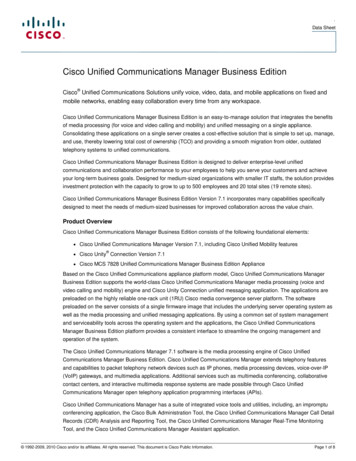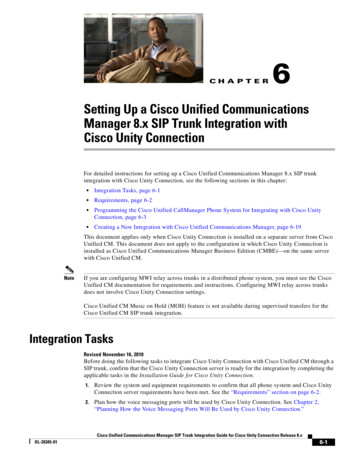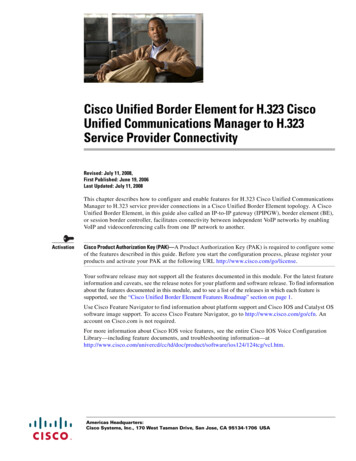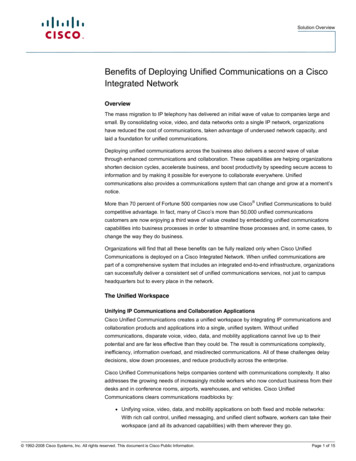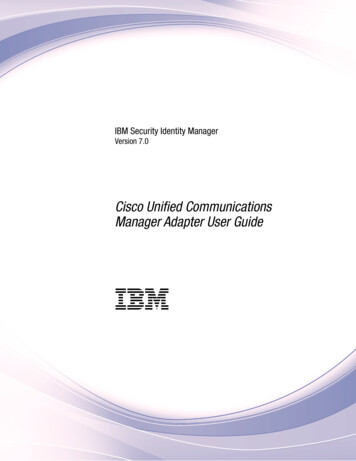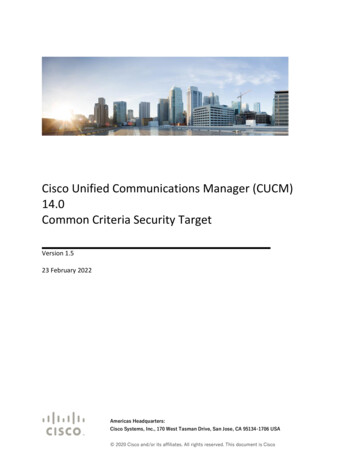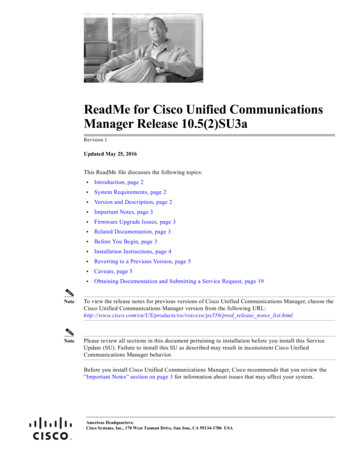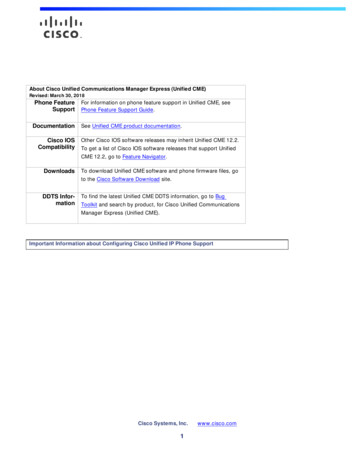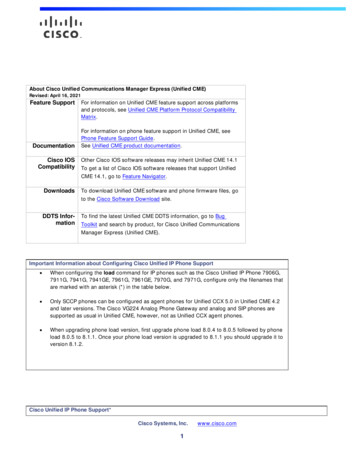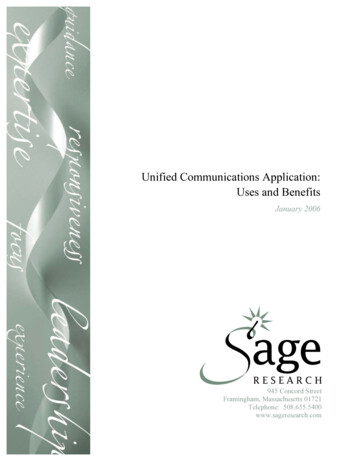
Transcription
Unified Communications Application:Uses and BenefitsJanuary 2006945 Concord StreetFramingham, Massachusetts 01721Telephone: 508.655.5400www.sageresearch.com
TABLE OF CONTENTS1.0Executive Summary11.1 The adoption context21.2 The benefits outlook32.0Scope and Methodology53.0Unified Communications applications63.1 Application usage63.2 Real-World Unified Communications application deployments7Unified Communications application benefits94.1 Employee Mobility94.2 Employee collaboration114.3 Cost savings13Conclusion164.05.0
LIST OF EXHIBITSExhibit 1: Relevant sources of pain3Exhibit 2: Unified Communications Benefits: Beyond Basic IPC Deployment4Exhibit 2a: Correlation between IPC application use and level of benefits4Exhibit 3: Current use of UC applications6Exhibit 4: Use of UC applications within organizations7Exhibit 5: Summary of Unified Communications Application Benefits9Exhibit 6: Time savings by knowing the best way to reach coworkers10Exhibit 7: Time Savings from using Unified Messaging11Exhibit 8: Time Savings by using Instant Messaging (IM)12Exhibit 9: Time savings from escalating IM session to live phone conversation12Exhibit 9a: Benefits by Size of Deployment in the Workplace13Exhibit 10: Cost savings from on-premise conferencing14Exhibit 11: Savings per month due to SoftPhone usage15
Page 1IPC Applications1.0Executive SummaryMany benefits of deploying an IP Communications (IPC) system are, by now, wellknown and well-documented. However, once the basic IPC foundation is set, there areseveral additional applications that can leverage this converged IP network even morefully. Quantifying the real productivity gains and out-of-pocket cost savings of theserelatively new value-added Unified Communications applications can be challenging forthose organizations considering an investment in IPC1. Yet if armed with suchinformation, potential adopters could make a far more comprehensive ROI justificationfor their planned deployments. One source of such information are benchmarks fromcurrent users data which until now has been in short supply.Based on a survey of over 200 small, medium, and large organizations presently using orplanning Unified Communications applications, this paper outlines both the challengesthat those applications address and the actual benefits that current adopters experience.This paper presents very specific results that quantify both staff-time and out-of-pocketcost savings that users have experienced by implementing Unified Communicationsapplications, thus giving decision-makers a real-world reference for evaluating thetechnology.Throughout the findings presented in this white paper, three general themes thatcharacterize the results are highlighted: Unified Communications applications lead to more effectivecommunication. Beyond replacing a traditional channel for contactingemployees, Unified Communications applications also enable smartercommunication. Employees can consult the best method for reaching coworkersbefore even initiating contact, thereby improving the efficiency in theirinteractions with others. Unified Communications application benefits include both time savingsand cost savings. Real-world users’ experiences clearly indicate that theseapplications provide both employee productivity benefits and direct monetarysavings. As a result, the ROI case for Unified Communications applications isfairly comprehensive. The level of Unified Communication application benefits increases withdeployment scope. Simply put, the more employees an organization equipswith a Unified Communication application, the greater the overall return. Whilethis is an intuitive finding, the size of this effect is dramatic.1Unified Communications applications are defined as applications built on an IP Communications system.These include Unified Messaging, Conferencing and Collaboration (such as voice and video conferencing),Enterprise IM integrated with IPC and SoftPhones, among others.Copyright 2006, Sage Research, Inc.
Page 2IPC Applications1.1The Adoption ContextA typical communications challenge facing many organizations today is an inability toreach coworkers reliably on the first try (see Exhibit 1). Even though communicationtools have proliferated, the fact that employees are become increasingly mobile makescollaborating with coworkers more difficult by the day. Workers today have no shortageof means for staying in touch. In fact, the average organization with IPC reports usingover six different types of communication devices (e.g., desktop phones, mobile phones,etc.) and five communication applications (e.g., instant messaging, conferencingapplications, etc.)2. However, employee mobility is an ever-present fact of life: onaverage, current IPC adopters report that 27% of their workforce travels at least once amonth.Working together, these two factors have led to a real communications bottleneck. Eventhough more tools should lead to easier coworker access, if the devices are not properlyintegrated the net effect can be counterproductive. In practice, employees must oftenguess which method (e.g., desk phone, cell phone, email, etc.) is best for reaching theircolleagues at any given time. Their first attempts often fail: in fact, 56% of organizationsreport that employees are unable to contact coworkers on the first try at least on a weeklybasis.Although this scenario might only seem a modest annoyance, it has real economicimpact. These internal communication obstacles lead to critical delays over time. In fact,nearly all organizations (93%) at one point have experienced a missed deadline or projectdelay as a result of impeded access to key decision-makers. Although the questionnairedid not quantify these setbacks in dollar terms, it is clear that being cut off from key teammembers will jeopardize core business operations in the long run.2Note: this average is based on IPC users only; averages for non-IPC users (not recorded in this study) mayvary.Copyright 2006, Sage Research, Inc.
Page 3IPC ApplicationsExhibit 1: Relevant sources of painCommunicationsDevices /Applications areProliferating The averageorganization uses:6.4 types of Comm.Devices4.8 Comm.Applications And employeesare becomingincreasinglymobile leading toemployees havingto try multiplemethods ofreachingcoworkers Employees end upusing multiplemethods to reach acoworker:Daily 52%Weekly 32%Occasionally 12% which, inturn, resultsin employeesbeing unableto reachcoworkers onthe first try Employees are unableto reach a coworkeron the first try:Daily 36%Weekly 20%Occasionally 31% which inevitablyresults in projectdelays and misseddeadlinesProjects get delayedas a result of inabilityto reach coworkers Weekly 13%Monthly 22%Quarterly 12%The averageorganization with IPChas 27% of itsemployees travelingat least once a month1.2The Benefits OutlookHow do Unified Communications applications alleviate this communication challenge?While there is no one cure-all solution, Unified Communications applications haveproven effective in addressing the employee access issue. Several of the savings reportedby the average Unified Communications application user directly relate to improvedemployee access. For example, employees at organizations using unified communicationclients with their IPC save a full 32 minutes a day on average by being able to reach othercoworkers on the first attempt.3 In addition, the average employee using unifiedmessaging saves 43 minutes per day from being able to manage all emails, voicemailsand faxes from a single inbox. As these results illustrate, Unified Communicationsapplications are enabling smarter communication practices, by giving workersintelligence that improves how they keep in touch.Furthermore, as illustrated by the graphic in Exhibit 2, the benefits of UnifiedCommunications applications are cumulative that is, these applications are unlockingproductivity in a wide array of operational areas and the resulting gains generally do notoverlap. For example, organizations that use SoftPhones and IPC conferencingexperience improvements in mobile employee productivity (time saved from theconvenience of SoftPhones) and time savings from easier-to-use in-house voiceconferencing.3“Unified Communications client” is a software-based client for desktops, laptops, or othermobile devices that integrates communications applications into a single interface for presence,device awareness, collaboration, video, telephony, IM, etc.Copyright 2006, Sage Research, Inc.
Page 4IPC ApplicationsExhibit 2: Unified Communications Benefits: Beyond Basic IPC imesavingsHostedconferencingfee avoidanceTime savings(greater coworkeraccessibility)Timesavings(ability to escalateIM chat to priseIMBasic dial tone/telephonytransport fee savingsIn addition, Unified Communications application benefits grow significantly withdeployment penetration. That is, those with extensive deployments report higher benefitsthan those with limited roll outs (see Exhibit 2a). In reality, this result makes sense: themore fully accessible employees there are in an organization, the greater the productivitybenefit should be for all.Exhibit 2a: Correlation between IPC application use and level of benefits (time orcost savings)Level of IPC application benefitHIGHLOW% of employees using IPC applicationsCopyright 2006, Sage Research, Inc.HIGH
Page 5IPC Applications2.0Scope & MethodologyWith the goal of helping decision-makers to assess the true impact of UnifiedCommunications applications, this white paper quantifies the specific benefits applicationusers report today, including both employee time savings and direct, out-of-pocket costsavings. The questionnaire results from 203 small, medium and large organizations (20 toover 100,000 employees) in this white paper can help decision-makers considering IPCadoption to build the business case at their own organizations.All participants responding to the questionnaire met the following criteria: Responsibility for influencing, evaluating, planning or managing theirorganization’s IP PBX (pure or hybrid)Already deployed, currently testing or planning an IP PBX (pure or hybrid)4Currently use at least one unified communications application (includinginstant messaging, voice mail, unified messaging, voice, video or webconferencing, PC-based SoftPhone, Unified Communication client or speechbased access to application)Respondents represent a wide range of industries, including education, financial services,government, healthcare/pharmaceuticals, manufacturing, professional services andretail/wholesale among others.4“Planning” is defined in the questionnaire as “have already budgeted for (IP PBX) and selected a vendor”Copyright 2006, Sage Research, Inc.
Page 6IPC Applications3.0Unified Communications ApplicationsWhile many first implement IPC as a simple traditional PBX replacement, current usershave now begun to integrate additional applications to take greater advantage of IPC’sproductivity benefits. These Unified Communications applications are beingimplemented in more and more areas throughout the workplace, as organizations deploythem for an expanding segment of their workforce.3.1Application UsageAdoption of these value-added Unified Communications applications has moved beyondminority status and is entering the mainstream of the IPC user base (see Exhibit 3). Eventhough this type of progression is expected over time, these data suggest that adoption ofthese applications is really picking up momentum. For example, 34% of theseorganizations using IPC have deployed unified messaging and a remarkable 56% usevideo conferencing (although not necessarily integrated with IPC). Not surprisingly,adoption for newer applications like unified communications clients (19%) is still modestat this time. It is important to note that these statistics only represent organizations thatcurrently use, trial or plan IPC today. Nevertheless, it is clear that IPC is being used formuch more than a basic “dial tone” replacement. More and more organizations areexploiting its productivity benefits with increasingly sophisticated applications.Exhibit 3: Current use of UC applicationsQ: Which of the following unified communications (UC) applications does yourorganization currently use?83%Voice Conferencing56%Video Conferencing50%Web Conferencing/CollaborationInstant Messaging - Enterprise IM36%34%Unified MessagingPC Based SoftPhone31%19%Unified Communications clients0%25%50%% of respondentsCopyright 2006, Sage Research, Inc.75%100%
Page 7IPC ApplicationsLikewise, the size of these application deployments within the organization is notinsignificant (see Exhibit 4). Most notably, the average unified messaging deploymentreaches a full 52% of employees. Also, those organizations with Enterprise IM report thatroughly half (46%) of their workforce is using the technology today. And even arelatively new application like PC-based SoftPhones has already been implemented for27% of employees. It is apparent that as organizations begin to experience theproductivity impact of Unified Communications applications, they are expanding its usein the organization to maximize those benefits.Exhibit 4: Use of UC applications within organizationsQ: Approximately what percent of your employees are currently using the followingunified communications (UC) application(s)?52%Unified Messaging (N 70)46%Instant Messaging - Enterprise IM (N 74)44%Unified Communications (N 38)Voice Conferencing (N 168)42%35%Web Conferencing/Collaboration (N 102)Video Conferencing (N 114)33%27%PC Based SoftPhone (N 62)0%25%50%75%100%% of respondentsNs vary3.2 Real-World Unified Communications ApplicationDeploymentsThis expansion of Unified Communications applications in the workplace not onlyinvolves provisioning the same technology to more employees but also seeking new usesfor each application. In fact, conversations with current IPC users illustrate the range ofpossibilities for their Unified Communications applications.For example, Compass Health, a medium-sized healthcare services provider, explainsthat Unified Messaging has addressed multiple problem areas in their organization.Aside from providing end-users a more efficient means for managing their voice-mailcommunications, their Unified Messaging system also allows them to broadcast messagesto the entire workforce. Their CIO explains. “There are more than 100 employees whoCopyright 2006, Sage Research, Inc.
Page 8IPC Applicationsdon’t have computers, but each employee has a phone and a voice-mail box. If we needto reach the entire staff, we can (now) do a voice-mail broadcast.”5Similarly, Mansfield Independent School District, a large K-12 school system, reportsthat videoconferencing with IPC has enabled several completely new educationalcapabilities. Not only has videoconferencing allowed for distance learning facilities thatcan be instantly set up in any classroom, they also enable “Vertical teaming for teachers,where they can collaborate and share information with each other. We even had studentclub meetings where, for example, several clubs from different schools held one meetingat one time from different campuses,” the district CIO explains. 65A full case study detailing ACHs IPC application experiences can be found roducts category customer case studies.html6A full case study detailing Mansfield Independent School District’s IPC application experiences can befound /products/ps556/c1950/cdccont 0900aecd80363830.pdfCopyright 2006, Sage Research, Inc.
Page 9IPC Applications4.0Unified Communications Application BenefitsJust as Unified Communication applications are gaining increased presence in theworkplace, so too are the benefits surfacing in more areas throughout the organization.The results from this primary research plainly demonstrate that Unified Communicationsapplication users experience a multitude of benefits – both in terms of employee timesavings as well as financial savings. Not only do Unified Communications applicationsbring productivity improvements for mobile employees, they can also favorably changeways in which all employees communicate (see Exhibit 5).Exhibit 5: Summary of Unified Communications Application BenefitsTime Savings from Unified Communications ApplicationsUnified Communication ClientsSoftPhonesEnterprise IM32 total min. saved/day by reaching workers on first try40 min. saved/traveling employee/travel day fromconvenience of SoftPhones51 minutes saved/employee/day by escalating IM chatsinto web conferences53 min. saved/employee/day by escalating IM chatsinto phone callsUnified Messaging55 min. saved/traveling employee/day from moreefficient message management43 min. saved/employee/day from more efficientmessage managementConferencing & collaboration30 min. saved/virtual conference set up throughOutlook/Notes integrationDirect Cost Savings from Unified Communications ApplicationsSoftPhoneConferencing & collaboration 1,727 saved/month from cell phone and long distanceavoidance30% reduction in conferencing expenses (from inhouse conferencing) 1,700 saved/month on travel avoidance4.1Employee MobilityEmployee mobility is an ever-increasing fact of life these days and IPC can be a primarytool for those who need to travel or simply work off-premises. With the help of UnifiedCommunications applications, mobile employees are becoming more accessible tocustomers, management and their own coworkers. In fact, the average employee atCopyright 2006, Sage Research, Inc.
Page 10IPC Applicationsorganizations using unified communications clients saves a surprising 32 minutes a dayby being able to consult the best method for reaching a coworker before attempting tocontact him/her (see Exhibit 6). Also, while such applications help users throughout theorganization, they benefit mobile employees even more. As illustrated in Exhibit 7, whilethe average employee saves 43 minutes per day by being able manage their voicemail,email and faxes from one inbox, traveling employees save a full 55 minutes.Exhibit 6: Time savings by knowing the best way to reach coworkersQ: On average, how much time do you and other employees at your organization saveduring a typical day as a result of automatically knowing the best way to reach yourcoworkers (desk phone, IM, cell phone, etc.) before trying to make contact?No time saved per employeeper day3%Average time savings32 min/day15 minutes or less25%16-30 minutes25%31-60 minutes25%More than 1 hour peremployee per day22%0%25%50%% of respondentsN 36Copyright 2006, Sage Research, Inc.75%100%
Page 11IPC ApplicationsExhibit 7: Time Savings from using Unified MessagingQ: How much time does the typical employee save at your organization by being able tocheck, manage, and respond to all voicemails, e-mails, and faxes from a single inbox?Q: How much time does the typical traveling employee save at your organization bybeing able to check, manage, and respond to all voicemails, e-mails, and faxes from asingle inbox?No time saved per day0%2%Average time savingsTypical employee: 43 min/dayTraveling employee: 55 min/day17%10 minutes or less8%11 - 20 minutes24%21%21 - 40 minutes23%21%18%19%41 - 60 minutes11%1 - 2 hours21%Typical Employee8%10%More than 2 hours per day0%Traveling employee25%50%75%100%% of respondentsN 66 (Typical employee), N 63 (Traveling employees)4.2Employee CollaborationThe growing use of instant messaging (IM) in the workplace has given employees a newand more immediate channel of communication. On average, employees using IM save31 minutes per day by having this additional means of access to colleagues (Exhibit 8).However, organizations that have also integrated their enterprise IM platforms with IPCoften see sizeable added savings with this increased functionality. For example, someintegrated IM users can seamlessly transfer an IM chat into a live telephone conversationwith a single click. This translates into an average time savings of 53 minutes per day peruser (see Exhibit 9) an impressive result compared to other savings levels reported in thesurvey.Copyright 2006, Sage Research, Inc.
Page 12IPC ApplicationsExhibit 8: Time Savings by using Instant Messaging (IM)Q: How much time does the typical employee save per day at your organization by beingable to reach any coworker, client, or partner via instant messaging?2%No time saved per employee per dayAverage time savings31 min/day23%10 minutes or less30%11 - 20 minutes21 - 40 minutes23%15%41 - 60 minutes1 - 2 hours4%More than 2 hours per employee per day4%0%25%50%75%100%% of respondentsN 114Exhibit 9: Time savings from escalating IM session to live phone conversationQ: How much time has the typical employee saved per day at your organization by beingable to escalate an instant messaging session into a live phone conversation with a singleclick?3%No time saved per employee per dayAverage time savings53 min/day8%10 minutes or less18%11 - 20 minutes21 - 40 minutes24%29%41 - 60 minutes1 - 2 hours5%13%More than 2 hours per employee per day0%25%50%75%100%% of respondentsN 38Furthermore, this research also demonstrates that the impact of a UnifiedCommunications application is directly tied to the size of its deployment (as a percentageof the total workforce) (Exhibit 9a.). For example, organizations deploying unifiedmessaging for up to 50% of their workforce experience 29 minutes of time saved perCopyright 2006, Sage Research, Inc.
Page 13IPC Applicationsemployee per day (from simplified voice and email communication management). Thatbenefit increases to a significantly higher 56 minutes at organizations with deploymentsreaching over 50% of their employees. This implies a type of “collaboration” effect thatis, the more employees an organization has who are fully accessible to their colleagues,the greater the overall productivity benefit (since all employees gain from a moreresponsive workforce).Exhibit 9a: Benefits by Size of Deployment in the Workplace7Up to 50% ofemployees usingUMOver 50% ofemployees usingUM(Q22) Time saved by checking/managing/responding to voice mails/emails/faxes fromsingle inbox (min/employee/day)2956(Q23) Time saved by checking/managing/responding to voice mails/emails/faxes fromsingle inbox (min/traveling employee/day)4267Up to 40% usingpublic IMOver 40% usingpublic IM1843Up to 40% usingenterprise IMOver 40% usingenterprise IM2344Up to 40% usingvoice conferencingOver 40% usingvoice conferencing 1,259 2,200(Q30) Time saved by being able to reachcoworker/client/partner via IM(Q30) Time saved by being able to reachcoworker/client/partner via IM(Q38) Amount in out-of-pocket expensessaved from reduced need to travel due toconferencing capabilities4.3Cost SavingsBeyond the employee productivity benefits, these value-added Unified Communicationsapplications also yield direct cost savings. Two areas where these are readily reported arein voice and web conferencing and SoftPhone use.7Note: all differences displayed this table are statistically significant.Copyright 2006, Sage Research, Inc.
Page 14IPC Applications Voice and web conferencing savings – Organizations that have transferred theirconferencing service in-house (using their own IPC system) after using a thirdparty hosted service report a sizeable average savings of nearly 30% for bothvoice conferencing and web conferencing (see Exhibit 10). SoftPhone savings By being able to use SoftPhone applications on theirlaptops or handhelds, employees no longer depend on cell phone, hotel phone orother landline long distance voice services. The net effect from this phenomenonis very real. In eliminating these per-minute service fees, organizations are savinga total of 1,727 on average per month per traveling employee (Exhibit 11). Notethat this total varies considerably, with some reporting over 5,000 per month insavings.Exhibit 10: Cost savings from on-premise conferencingQ: Has your organization been able to reduce its expenditures on conferencing as aresult of bringing this in-house and running conferencing traffic over your privatenetwork (as opposed to using a hosted solution)? If so, approximately how much has yourorganization reduced its monthly conferencing expenses by doing this?No money saved per month1 - 10% reduction4%Average expense reductionVoice Conf.: 29% expense reductionWeb Conf.: 28% expense reduction4%11%8%42%11 - 25%48%27%26 - 50%27%10%51 - 75%4%76% reduction per month0%Voice Conferencing6%Web Conferencing8%25%50%75%% of respondentsN 102 Voice conferencing users, N 48 Web conferencing usersCopyright 2006, Sage Research, Inc.100%
Page 15IPC ApplicationsExhibit 11: Savings per month due to SoftPhone usageQ: For employees that are traveling outside of the office, how much is your organizationsaving in long distance charges, hotel phone charges, and cell phone bills as a result ofthese employees having SoftPhone capabilities on their laptops or handhelds?38%Less than 500 per month 1,000 - 1,9995% 2,000 - 2,9995% 3,000 - 3,999 4,000 - 4,999 5,000 or more per month0%Average savings 1,727 per month24% 500 - 9997%4%16%25%50%% of respondentsN 55Copyright 2006, Sage Research, Inc.75%100%
Page 16IPC Applications5.0ConclusionWhile the use of Unified Communications applications is clearly on the rise, thistechnology is still in its infancy stage. However, by deploying an IPC system today, anorganization is laying the groundwork for a new world of potential value-addedapplications. The projected future uses of IPC in the workplace are varied and farreaching. For example, retail employees could use Unified Communications applicationsto track and manage product inventory in real time using voice commands over an IPphone. Doctors and nurses in a hospital could someday gain remote access to patient testresults over an IPC system or even discuss via a conference bridge a critical case that hasjust been admitted as they all rush to surgery. Teachers could take student attendance andeven locate their students anywhere in the building all from an IP phone. While most ofthese ideas are still more concept than reality today, the bottom line is that once an IPCsystem is in place, the possibilities for new applications are really wide open.Until now, many organizations have adopted IPC primarily in the name of cost savings.However, as demonstrated in this research, the more organizations exploit IPC as aplatform for higher-end Unified Communications applications today the more benefitsthey experience both on the employee productivity side as well as in direct cost savings.In addition, future plans for Unified Communications applications strongly suggest thatthis technology will not only bring operational efficiencies but also provide a real sourceof competitive advantage in the long run.Copyright 2006, Sage Research, Inc.
3.0 Unified Communications applications 6 3.1 Application usage 6 3.2 Real-World Unified Communications application deployments 7 4.0 Unified Communications application benefits 9 4.1 Employee Mobility 9 4.2 Employee collaboration 11 4.3 Cost savings 13 5.0 Conclusion 16

